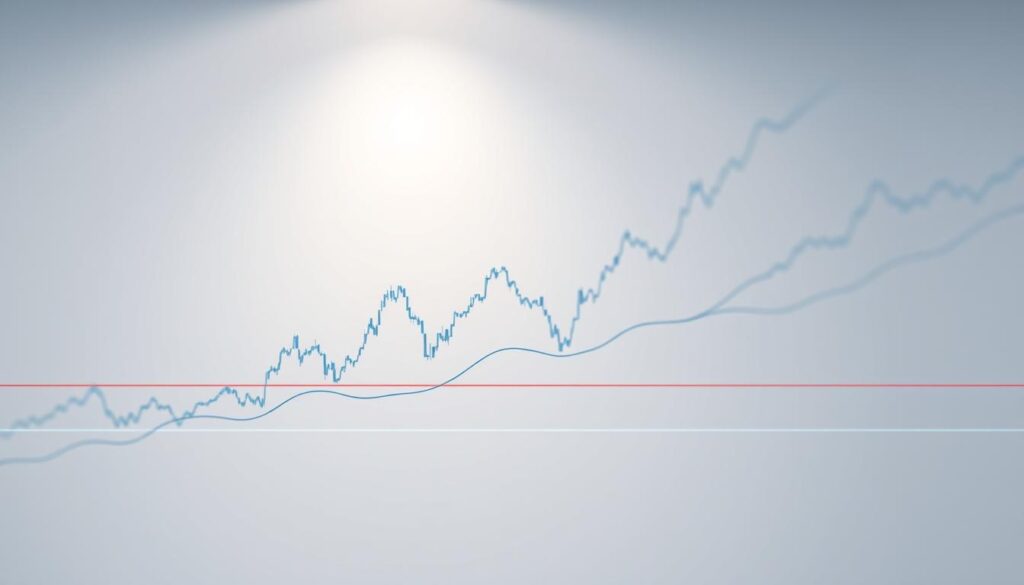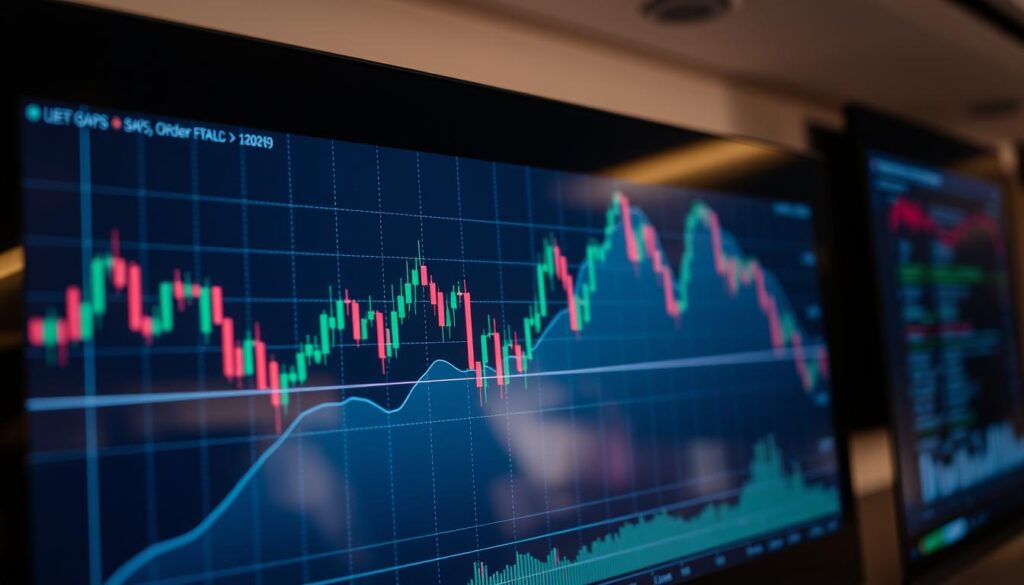Now Reading: Effective Crypto Price Action Trading Strategy Techniques
- 01
Effective Crypto Price Action Trading Strategy Techniques
Effective Crypto Price Action Trading Strategy Techniques

Many people feel overwhelmed by complex charts filled with technical indicators. This guide offers a simpler, more direct method for understanding market movements.
The core idea is to study the raw movement of values over time. This technique strips away the noise to focus on what truly matters. It is a highly visual and intuitive way to spot trends.
This method treats the chart like a storybook. Each movement tells you about the decisions of other participants. You learn to identify patterns that often repeat themselves.
Unlike traditional systems that can create clutter, this approach concentrates on key levels and the psychology behind moves. It is a versatile skill suitable for beginners and experienced market participants alike.
Key Takeaways
- Focuses on analyzing raw price movements instead of complex indicators.
- Provides a clear, visual method for identifying market trends.
- Helps cut through noise to understand fundamental market behavior.
- Based on recognizing repeatable patterns and key chart levels.
- A versatile skill applicable to various markets, including digital assets.
- Suitable for traders at all levels of experience.
Introduction to the Crypto Trading Landscape
The digital asset marketplace operates with distinct characteristics that set it apart from traditional finance. Its constant operation and rapid value shifts create a unique environment for participants.
This landscape is defined by high volatility and non-stop activity. These factors provide numerous chances to observe pure market behavior.
Overview of Cryptocurrency Market Dynamics
Several dynamics make this space ideal for chart-based study. The transparency of blockchain data and global nature of participation are key.
Strong psychological factors drive rapid sentiment changes. This leaves clear patterns on charts for skilled individuals to interpret.
Participants range from individual enthusiasts to large institutions. Each group leaves a distinct footprint in the market’s movement.
The Role of Technical Analysis
Technical analysis is the framework for understanding these movements. It involves studying charts to predict future direction.
This field rests on three core ideas. First, the market action discounts everything, meaning all known data is reflected in the value. Second, values tend to move in trends. Finally, history tends to rhyme, with patterns often repeating.
Analysts believe the collective wisdom revealed through charts offers actionable knowledge. This approach helps people time their market decisions more effectively.
Foundations of Price Action Trading
This technique strips away all complexity to reveal the pure narrative of supply and demand. It operates on a simple belief: every piece of necessary information is already visible in the chart’s movement. There is no need for lagging mathematical tools.
Basic Principles and Terminology
The core principles are straightforward. Values fluctuate based on the constant battle between buyers and sellers. Recognizable formations emerge from collective market psychology, offering clues about future direction.
Learning the essential vocabulary is your first step. Key terms include support zones where buying interest increases, and resistance levels where selling pressure typically intensifies. Other critical concepts are swing highs, swing lows, and consolidation phases.
A major advantage is the clarity of an uncluttered chart. Removing distracting indicators allows you to see genuine market behavior. This provides real-time insight without the delay of derivative calculations.
This skill set is universally applicable across different timeframes and markets. While the concepts appear simple, true mastery demands dedicated practice in pattern recognition. It requires the discipline to wait for high-probability setups to develop naturally.
crypto price action trading strategy
High-probability opportunities emerge when multiple signals align at a single, significant chart level. This concept, known as confluence, is the foundation of a robust methodology. It combines elements like support zones, candlestick formations, and volume into a cohesive plan.
This approach is especially powerful in digital asset markets. Their constant operation means clean, real-time signals are more reliable than lagging tools. You get a clearer view of genuine market behavior without the noise of traditional indicators.
A strong framework for this methodology includes several key steps:
- Identify the market structure: Is the asset trending upward, downward, or moving sideways?
- Spot key levels: Look for zones where the value has historically reversed or paused.
- Watch for confirmation: Wait for a candlestick pattern or increased volume at these levels.
It is crucial to adapt general principles to the unique nature of this space. Factors like the influence of major holders and rapid news-driven moves create distinct patterns. A successful plan acknowledges these dynamics to capitalize on clear signals.
Mastering Support and Resistance in Crypto Markets
The most reliable chart formations emerge from clear zones where buyer and seller interest converges. These critical areas represent the foundation of market structure analysis.
They show where significant buying or selling pressure typically appears. Recognizing these zones helps predict potential turning points.

Determining Key Support Zones
Support zones indicate areas where buying demand becomes strong enough to halt declines. Look for prices where an asset has repeatedly bounced upward.
These are not exact numbers but rather ranges where buyers consistently enter. Historical bounce points and psychological round numbers often create strong support.
Identifying Major Resistance Levels
Resistance levels form where selling pressure intensifies, preventing further upward movement. They typically develop at previous significant highs.
Areas with heavy historical volume or where profit-taking occurs frequently become major resistance. The strength increases when tested multiple times.
Recognizing Candlestick Patterns in Crypto Price Action
Candlestick charts, with origins in 18th-century Japan, translate market psychology into a simple visual language. Each bar captures the opening, closing, high, and low for a period, forming a complete narrative.
The body shows the range between the open and close. The wicks, or shadows, indicate the highest and lowest points reached. This structure is the foundation for all pattern recognition.
Understanding Bullish and Bearish Formations
Specific shapes signal potential momentum shifts. A hammer pattern, with a small body and long lower wick, suggests buyers are stepping in after a decline.
Conversely, a shooting star with a small body and long upper wick hints that sellers are gaining control during an advance. These single-bar formations offer early clues.
Key formations to watch for include:
- Bullish Engulfing: A large green candle completely covers the previous red one.
- Bearish Engulfing: A large red candle swallows the prior green candle.
- Doji: A candle with a very small body, indicating indecision.
Spotting Reversal Signals
The real power of these formations comes from their context. A hammer pattern holds more weight when it appears at a known support level.
Likewise, a shooting star is more significant near a major resistance zone. These reversal signals are strongest when multiple patterns align.
Always look for confirmation across several timeframes. This approach helps filter out false signals and identify high-probability opportunities.
Trend Lines, Channels, and Chart Patterns
The most fundamental way to understand market direction is by drawing lines between significant highs and lows. These simple visual tools reveal the underlying momentum of buyer and seller activity.
An upward trend shows buyers in control, creating a series of higher lows. A downward trend indicates seller dominance with lower highs. Sideways movement suggests consolidation where neither group has clear advantage.

Valid trend lines gain significance when tested multiple times. The more touches a line receives, the stronger it becomes as support or resistance. This demonstrates consistent market interest at specific angles.
When two parallel lines form a channel, they create predictable boundaries. These patterns offer clear entry and exit points during ranging markets. Breakouts from channels often signal important direction changes.
Common chart formations like triangles and rectangles emerge from these lines. Each pattern tells a story about market psychology and potential next moves. Recognizing these patterns helps anticipate future price action.
The beauty of this approach lies in its flexibility across different market conditions. While trend lines work exceptionally well during clear directional phases, successful participants adapt when markets transition between trending and ranging behavior.
Volume Analysis: Gauging Market Strength
Volume serves as the market’s heartbeat, revealing the true intensity behind every move. This metric measures participation levels and validates the strength behind chart patterns.
When asset values change, volume provides essential context about the move’s sustainability. High activity confirms genuine interest, while low activity suggests weak conviction.
Confirming Price Movements with Volume
Volume acts as a reliability gauge for market participants. Significant moves accompanied by substantial activity carry higher probability of continuation.
Breakout situations benefit greatly from volume confirmation. A surge above key levels with strong participation indicates robust momentum.
| Volume Pattern | Market Interpretation | Reliability Level |
|---|---|---|
| High volume on advance | Strong buyer conviction | High |
| Low volume on advance | Weak momentum, likely reversal | Low |
| Volume spike at resistance | Potential exhaustion point | Medium-High |
| Increasing volume during trend | Healthy sustained movement | High |
| Declining volume during drop | Selling pressure exhausting | Medium |
Successful market analysis combines volume study with other technical elements. This multi-factor approach provides stronger confirmation signals for informed decisions.
Essential Tools for Effective Price Action Analysis
Effective market observation requires a carefully chosen set of analytical instruments. The right equipment enhances your ability to spot patterns and make informed decisions.

Quality resources don’t need to break the bank. Many excellent platforms offer free versions with robust features for serious market participants.
Choosing the Right Charting Platform
Selecting appropriate software is crucial for accurate analysis. Look for platforms that provide clean candlestick displays and intuitive drawing tools.
Key features include multiple timeframe viewing and volume indicators. These elements help confirm market movements and identify significant levels.
Popular options like TradingView offer comprehensive toolkits. Their free versions provide most essential functions for effective chart examination.
Risk Management and Trade Journaling
Protecting your capital is as important as finding opportunities. Position size calculators help determine appropriate investment amounts based on your risk tolerance.
Stop-loss orders automatically exit positions when markets move against you. This disciplined approach prevents emotional decision-making during volatile periods.
Maintaining detailed records of your market activity accelerates learning. Documenting your reasoning and outcomes creates valuable insights for future improvement.
Understanding Market Structure and Supply/Demand Zones
Market structure provides the essential framework for interpreting asset movements. It organizes seemingly random swings into recognizable patterns that define directional bias.
You identify structure by analyzing swing points. Higher highs with higher lows signal an uptrend. Lower highs with lower lows indicate a downtrend. Sideways movement shows consolidation.
Recognizing the current market structure determines which approaches have the highest probability. This understanding forms the foundation for effective decision-making.
Supply and demand zones represent areas where significant buying or selling previously occurred. These broader regions often attract activity during future pullbacks.
Mark these zones using rectangles on your charts. Demand zones show where buying pressure emerged. Supply zones indicate previous selling pressure.
These areas often work better than single lines. They account for institutional orders creating zones of interest rather than precise points.
Look for areas where movement away was sharp and strong. This indicates significant unfilled orders remain at those levels.
Structural breaks occur when price violates key highs or lows. These breaks signal important shifts in buyer-seller balance.
Decoding Price Gaps and Order Flow
Gaps in chart patterns represent moments when market sentiment shifts abruptly overnight. These empty spaces appear when an asset’s value jumps significantly between periods.

Markets often return to fill these gaps later. This happens because participants dislike leaving price zones untested. The phenomenon provides potential profit opportunities.
| Gap Type | Market Signal | Probability of Fill | Time Frame |
|---|---|---|---|
| Breakaway Gap | New trend beginning | Low | Days to weeks |
| Runaway Gap | Trend acceleration | Medium | Weeks |
| Exhaustion Gap | Trend ending | High | Days |
| Common Gap | Normal fluctuation | Very High | Hours to days |
Order flow reveals the real-time battle between buyers and sellers. It shows where large orders are placed before movements become obvious on charts.
Understanding this flow provides an edge by revealing institutional accumulation patterns. Even basic concepts like monitoring bid-ask spreads offer valuable insights.
Watch for clusters of buy orders creating demand walls below current levels. Similarly, sell order clusters above indicate potential resistance areas.
Advanced Patterns: Reversal and Continuation Setups
Moving beyond basic formations, advanced chart patterns offer deeper insights into potential market shifts. These sophisticated setups are categorized into two main groups: those signaling a change in direction and those indicating a temporary pause before the existing movement resumes.
Exploring Reversal Patterns like Head and Shoulders
Reversal patterns help identify when a strong trend may be exhausting. The classic head and shoulders formation is one of the most reliable.
This pattern features three peaks. The middle peak (the head) is the highest, flanked by two lower peaks (the shoulders). A neckline connects the low points between these peaks.
A break below this neckline confirms the reversal signal. Other important reversal formations include double tops and bottoms.
Identifying Continuation Patterns for Trend Confirmation
Continuation patterns suggest the market is taking a breather. The prevailing trend is likely to continue after this consolidation.
Flags and pennants are common examples. They represent short, tight ranges that slope against the main trend.
A breakout from these patterns often leads to a powerful resumption of the prior move. This provides excellent entry opportunities.
To trade these setups effectively:
- Wait for a confirmed breakout from the pattern’s boundary.
- Place a stop-loss order on the opposite side of the formation.
- Calculate profit targets based on the pattern’s height.
Pattern reliability increases significantly when they form at key support or resistance levels. High volume on the breakout adds further conviction to the signal.
Popular Price Action Trading Strategies
Developing a consistent edge in markets involves implementing structured methods based on visual signals. These approaches help participants make informed decisions using chart patterns and key levels.
Effective methodologies combine pattern recognition with disciplined execution. They provide clear frameworks for entering and exiting positions.
Trend Following and Retracement Entries
This approach capitalizes on existing momentum by waiting for temporary pullbacks. When an asset moves strongly in one direction, it often experiences brief reversals.
These retracements offer favorable entry points before the main movement resumes. Look for pullbacks to key support or resistance zones combined with reversal candlestick formations.
Patience is essential for identifying high-quality setups. Wait for confirmation signals before entering in the primary trend’s direction.
Breakout Strategies for Dynamic Markets
Breakout methods focus on significant movements through important chart levels. They work well during periods of compression followed by expansion.
Identify consolidation patterns where values trade in tight ranges. A strong move beyond these boundaries signals potential continuation.
Volume confirmation and candlestick conviction help distinguish genuine breakouts from false signals. This approach captures explosive moves that follow compression phases.
Integrating Technical Analysis with Price Action Methods
Successful market analysis often involves knowing when to incorporate additional confirmation tools without compromising clarity. While pure chart reading provides the clearest view of market behavior, some participants find value in thoughtful integration.
The key is maintaining balance. Indicators should never override what the chart itself reveals. They serve as supplementary confirmation rather than primary decision drivers.
Combining Indicators with Pure Price Action
Moving averages can identify dynamic support and resistance levels. Momentum oscillators reveal divergences between movement and underlying strength. These tools complement pattern recognition when used sparingly.
Always prioritize the chart’s story. Use indicators to confirm what patterns and levels already suggest. This approach prevents analysis paralysis from conflicting signals.
Experiment to find your optimal balance. Some thrive with completely clean charts. Others benefit from one or two carefully selected tools that enhance rather than complicate their process.
Risk Management Strategies for Price Action Trading
Disciplined risk control separates successful participants from those who experience significant losses. Even perfect pattern recognition becomes meaningless without proper capital preservation techniques.
Position sizing forms the foundation of effective risk management. Calculate your trade size based on the distance to your stop level. This ensures potential losses remain within your predetermined risk tolerance.
Set logical exit points using chart analysis rather than arbitrary distances. Place stop orders just beyond key support or resistance zones. This approach invalidates your trade idea when the market moves against your analysis.
Profit targets should align with significant chart levels or pattern measurements. Aim for risk-reward ratios of at least 1:2. This means potential gains should outweigh potential losses.
Advanced exit strategies include scaling out of positions. Take partial profits at initial targets while letting remaining positions run. Use trailing stops to protect profits during extended moves.
Maintain detailed records of all your trades. Document your reasoning behind entry and exit decisions. This practice helps traders identify which setups work best for their style.
Psychological discipline prevents emotional trading mistakes. Avoid revenge trades after losses and resist moving stops. Only risk amounts you can comfortably afford to lose.
Real-World Examples and Case Studies in Crypto Trading
Theoretical knowledge becomes truly valuable when applied to actual market situations with real money at stake. This section examines two detailed case studies that demonstrate successful implementation of pattern recognition.
Case Study: Successful Head and Shoulders Trade
A classic reversal pattern appeared on a major digital asset chart. The formation developed at a significant resistance level with clear volume confirmation.
The right shoulder formed lower than the left, indicating weakening momentum. Entry occurred after the neckline break with increased activity. Stop placement above the right shoulder protected capital.
Profit targets used the measured move technique. This trade succeeded due to multiple confirming factors aligning perfectly.
Case Study: Trading Breakouts in a Consolidating Market
Another opportunity emerged during a period of compression. Values traded in a tight range with declining volume showing equilibrium.
The explosive upward move came with massive participation. Entry followed the strong breakout candle close above resistance. Stop placement below the consolidation zone managed risk effectively.
Targets were set at previous swing highs representing logical resistance. The high volume spike provided additional confidence in the move’s sustainability.
These examples highlight how proper risk management turns even failed setups into learning opportunities. Successful trades result from patience and discipline more than perfect pattern recognition.
Conclusion
True proficiency in market analysis comes from learning to read between the lines of chart movements and psychological patterns. This comprehensive guide has shown how price action provides a clear window into genuine market behavior.
The power of this approach lies in its elegant simplicity. By focusing on core concepts like support zones and candlestick formations, participants develop market-reading skills that work across all timeframes. These abilities become more refined with consistent practice.
Begin your journey by mastering one or two reliable setups. Patient observation and disciplined execution will build your confidence. Remember that sustainable success comes from quality decisions, not frequent activity.
This methodology offers a lifetime skill for navigating digital asset movements. The reward for your dedication is a profound understanding of how markets truly operate.
FAQ
What is the main advantage of using a price action methodology?
The primary benefit is its focus on raw market data, like movements and patterns, rather than lagging indicators. This approach helps traders make decisions based on the actual supply and demand dynamics visible on the chart.
How reliable are support and resistance levels in the cryptocurrency market?
These levels are highly significant as they represent areas where buying and selling pressure have historically clashed. Their reliability increases when confirmed by high volume and when they align with broader market structure points.
Can price action strategies be used for short-term trades like scalping?
Absolutely. Techniques such as trading breakouts from consolidation or using candlestick patterns for quick entries are very effective for short-term timeframes. The key is adapting the strategy to the faster pace.
What is the best way to confirm a breakout using this approach?
A valid breakout is best confirmed by a strong close beyond the level, accompanied by a significant increase in trading volume. This combination suggests genuine momentum and reduces the chance of a false signal.
How important is volume analysis in this type of market analysis?
Volume is a critical tool for gauging the strength behind a move. It helps distinguish between a weak price fluctuation and a strong, committed directional shift, providing essential confirmation for signals.
Are complex patterns like head and shoulders common in digital asset charts?
Yes, these classic formations appear frequently and can signal potent trend reversals. Their effectiveness lies in their ability to visually represent a shift in market sentiment from bullish to bearish, or vice versa.















